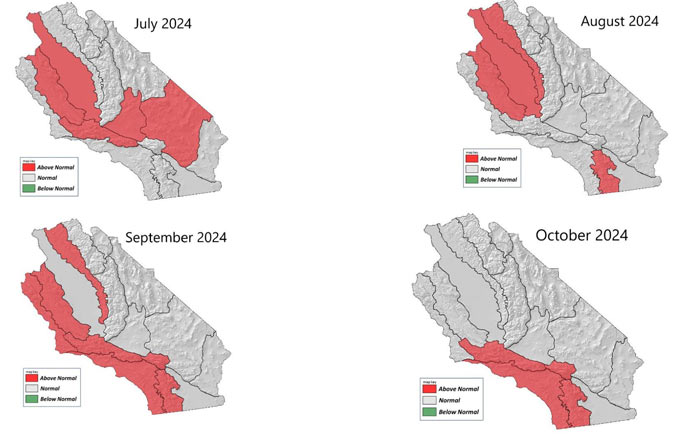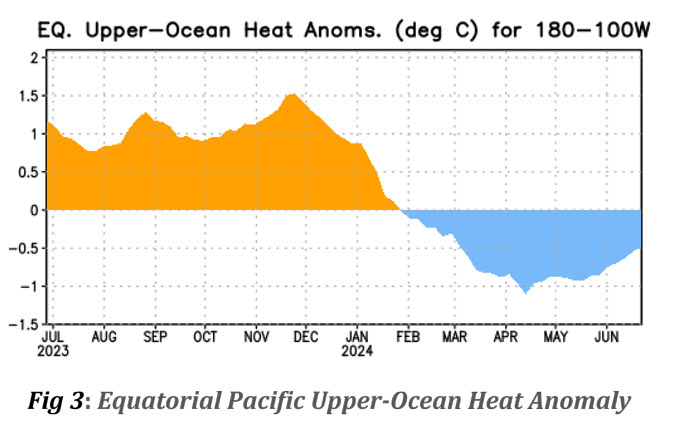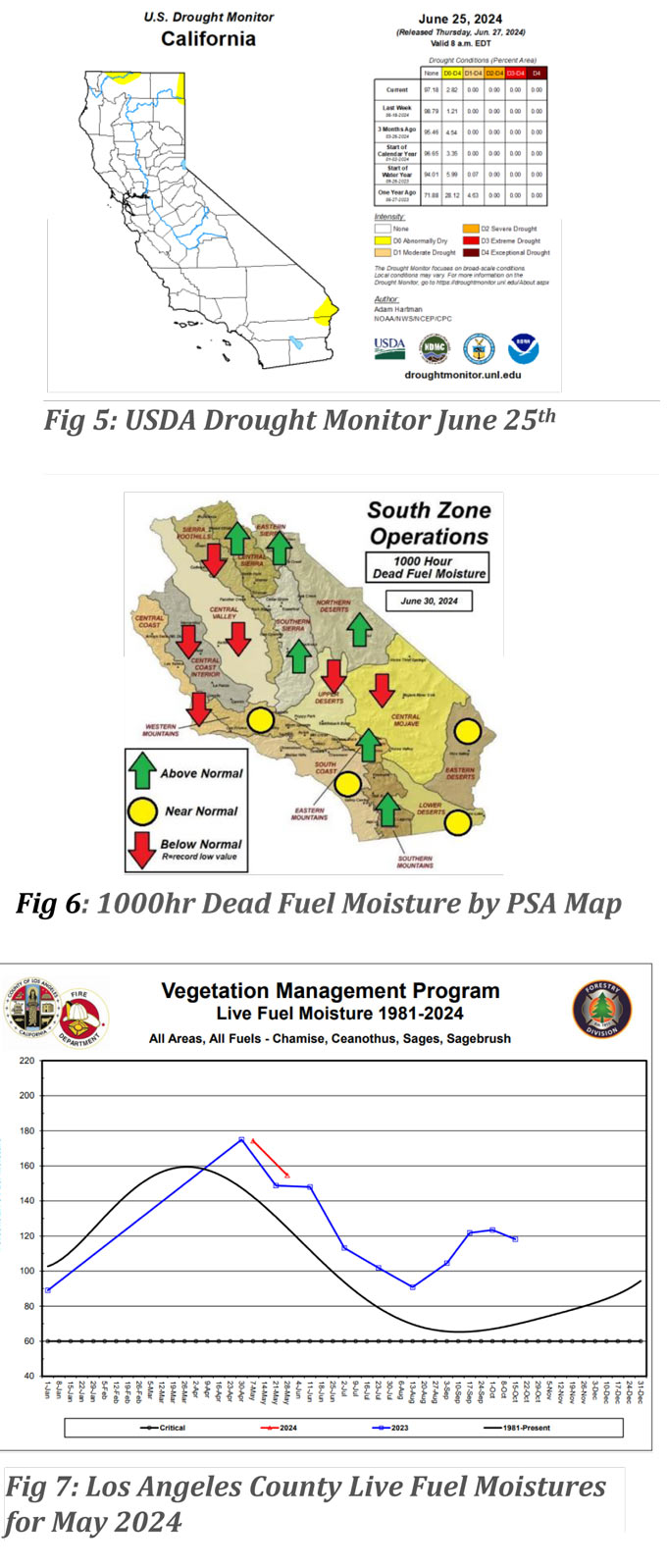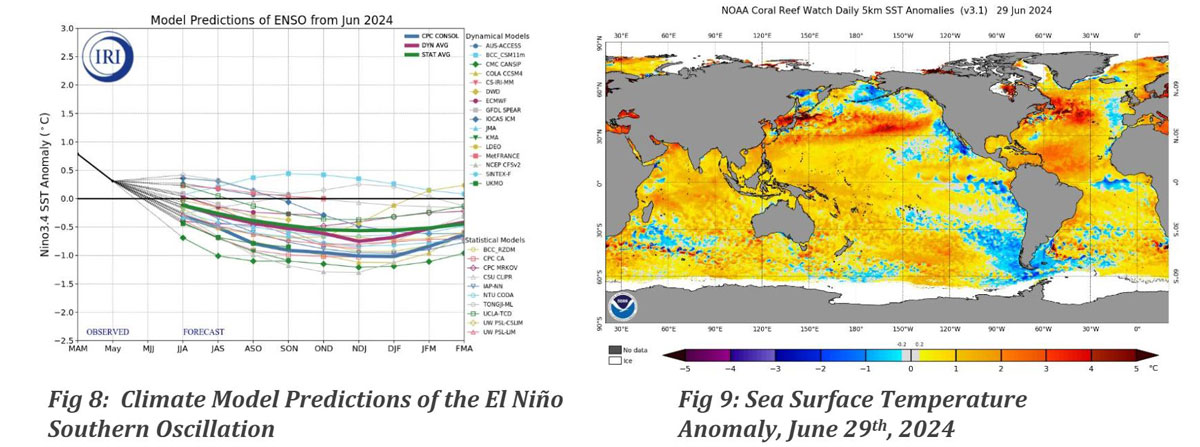
July 1, 2024 - July– October 2024 South Ops Highlights
• There is a slight to moderate tilt in the odds towards above normal large fire potential over the next 4-months for all areas shaded in red.
• Large fires are likely to be primarily grass dominated and fine fuels dominated.
• Due to the anomalously wet winter and spring season, there is an abnormally large load of grass crop and fine fuels which are now cured at elevations below 3000ft. More curing is expected over the next 4 months.
• Due to no areas of prolonged drought, larger live fuels (timber) are much less susceptible to curing as well as less susceptible to ignitions.
Weather Discussion
Since the start of the water year (October 1st), Southern California has received above average precipitation across most of the region (Fig 2). The largest wet anomalies are along the South Coast and through the high desert. Some areas in those two regions received over 150% of the average precipitation since October 1st . The driest areas are along the leeward slopes of the Southern Sierra and portions of the lower and eastern deserts. Some of the driest areas only received 70-80% of their average precipitation since October 1st . Temperature departures over the last month show most areas between 2-6oF above average (Fig 1).
 Latest sea surface temperature (SST) pattern across the equatorial Pacific shows the continuation of a cooling pattern as the El Niño Southern Oscillation (ENSO) continues to transition from the El Niño state to the La Niña state (Fig 3). The current state of ENSO at the end of June, 2024 is in the range between ENSO neutral and a weak La Niña state.
Latest sea surface temperature (SST) pattern across the equatorial Pacific shows the continuation of a cooling pattern as the El Niño Southern Oscillation (ENSO) continues to transition from the El Niño state to the La Niña state (Fig 3). The current state of ENSO at the end of June, 2024 is in the range between ENSO neutral and a weak La Niña state.
Fuels Discussion
A Fuels and Fire Behavior Advisory is currently in effect for central and southern California for areas under 3,000ft.
Latest USDA Drought Monitor indicates zero areas in drought status across central and southern California (Fig 5). There is a small area of abnormally dry conditions (D0) in eastern Riverside and San Bernardino counties, though abnormal dryness does not constitute drought status.
Due to the aforementioned anomalously wet winter and spring, there is a much larger than normal load of fine fuel, especially grasses. Due to warm and dry conditions for May and June 2024, these fine fuels are cured at elevations below 3,000ft. Grass fire activity was above average during June as a result of the large load of cured fine fuels below 3,000ft. The current 100hr fuels are anomalously drier in the western portions of the geographic area since monsoonal moisture allowed for shower and thunderstorm activity to moisten the finer fuels in the deserts. Larger dead fuel (1000hr fuel) remains below normal for several Predictive Services Areas (PSAs) and have become more susceptible to ignition (Fig 6).
Live fuel however continues to remain near to mostly above normal for live fuel moisture (Fig 7). Reports from the Post Fire in Los Angeles County and the Flash Complex Fire in Fresno County show the larger live fuels remaining unburned despite finer fuel types around these larger fuels are all burned. Reports from the Flash Complex Fire indicate the live timber fuels are not very susceptible as only the finer fuels in the understory appear to be igniting.

SOUTH OPS OUTLOOK
Climate models continue to suggest there is a high probability towards the continuation of the transition towards the La Niña state of ENSO (Fig 8). There is a slight tilt in the odds towards above normal temperatures for the next 4-month period. There are equal chances in the odds towards above, near and below normal precipitation for the southeastern portions of the South Ops area and a slight tilt in the odds towards below normal precipitation for the northern and western portions of the South Ops area for the next 4-month period.
La Niña patterns typically constitute a predominantly warmer and drier weather pattern. However, there is a large degree of uncertainty with respect to the monsoon forecast this season. Cold SST anomalies have significantly weakened off the California coast (Fig 9) while there is a strong tilt in the odds towards a well above normal Atlantic tropical cyclone season. The more active Atlantic and Gulf of Mexico means there is likely to be more moisture to move into the southwestern U.S. Due to the cold SST anomalies off the California coast weakening, this means there is a greater chance of the monsoonal moisture to reach further west locations. However, no strong signals are present to determine if the orientation of the high pressure over the desert southwest will allow this moisture to reach southern California.
With respect to large fire potential, there is a moderate tilt towards above normal fire activity for several PSAs due to the aforementioned large grass crop and fine fuel load combined with periods of prolonged warm and dry conditions to increase the receptiveness of these fuels. The odds tilt in favor of fire season 2024 being more of a grass dominated and fine fuels dominated fire season compared to a timber year since the large live fuels are significantly less receptive due to the lack of the presence of prolonged drought conditions. The eastern and central Sierra have a slight tilt in the odds towards near-normal large fire potential due to the well above live fuel moistures in the large timber dominated fuels, however the finer fuels in the understory are more susceptible to ignition.
 Source: Predictive Services
Source: Predictive Services








